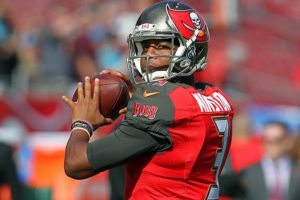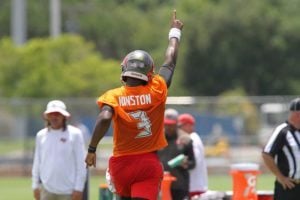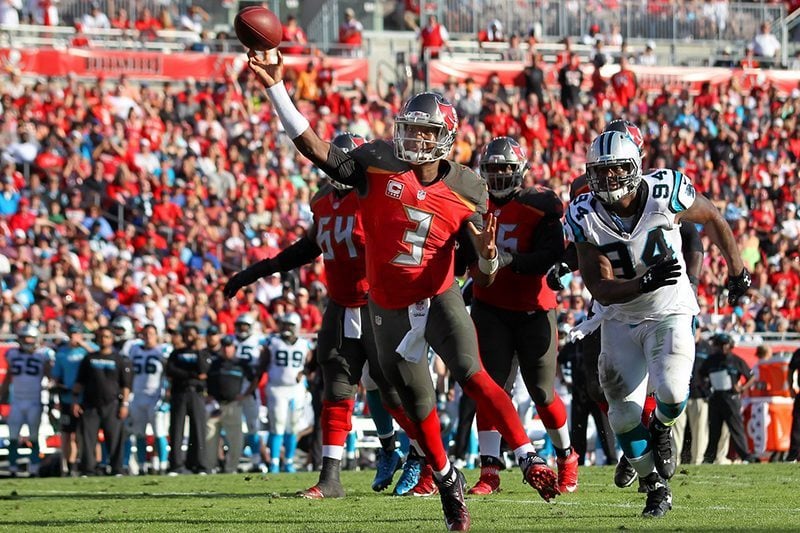SR’s Fab 5 is a collection of inside scoop, analysis and insight from yours truly, PewterReport.com publisher and Bucs beat writer Scott Reynolds. Here are a few things that caught my attention this week at One Buc Place and around the NFL.
FAB 1. Bucs, Winston Expecting A Big Year 3
When Tampa Bay made quarterback Jameis Winston the No. 1 overall pick in the 2015 NFL Draft, the Bessemer, Ala. native shed the No. 5 jersey he wore as a National Championship winning Heisman Trophy recipient at Florida State in favor of No. 3 as an NFL player.
The last Buccaneer to wear No. 5 was quarterback Josh Freeman, a failed first-round pick in 2009. Winston wore No. 3 – a jersey number that had no prior relevance in Tampa Bay – back in youth league football and is quickly making it one of the most important numbers in franchise history.
In 2017, the number 3 on Winston’s chest will have even greater significance, as it will be the third season for the team’s young, star QB, and his most important season yet. Not only will he be under the watchful eye of HBO’s Hard Knocks cameras, which will put him on center stage nationwide in the month of August, Winston and his teammates are fully expected to deliver a playoff season in Tampa Bay this season.

Bucs QB Jameis Winston – Photo by: Cliff Welch/PR
That directive isn’t just coming from hopeful, postseason-starved Bucs fans. That’s coming from the Glazers themselves.
Perhaps more important than what 2017 means to the Bucs franchise in terms of wins and losses, is what 2017 means to Winston’s development as the franchise quarterback.
You see, for young quarterbacks that have started early in their careers, Year 3 is typically the year that those QBs take off and ascend to new heights. If the Bucs want to elevate their record from last year’s 9-7 season, Winston will have to elevate his game this year.
The key to Winston’s success will not necessarily be about making more plays in 2017. It will be about making smarter plays with the football more often. That means cutting down his number of interceptions.
Winston’s critics – and skeptics – point to his 33 interceptions over his first two seasons as a red flag that he may never live up to the hype of being the first overall selection in the 2015 NFL Draft ahead of Marcus Mariota, a player that has far fewer career picks (19), but a few less passing touchdowns (five), too.
NFL coaches will tell you it is much harder to teach an average NFL player how to make more plays than it is to teach a gifted player how to make fewer mistakes. And Winston is quite gifted – and smart enough to realize that he and the Bucs will make big strides with fewer turnovers in 2017.
“When you come into the league as a rookie, you had great success in college but you’re playing with grown men now,” Bucs head coach Dirk Koetter said at the team’s mini-camp in June. “There’s just a lot more thrown at you. The disguise is so much different, the way the defense looks. He’s been through 32 NFL starts. Experience is the best teacher. We’ve talked about this before. The Tom Bradys and Matt Ryans of the world have got a lot of reps on Jameis.”
With two record-setting years under his belt, don’t be alarmed over Winston’s interceptions just yet. He’s in some elite company with several of football’s greatest quarterbacks having very similar starts to their careers.
I’ve chosen five quarterbacks whose stats draw close comparisons to Winston’s to illustrate my point – Dallas’ Troy Aikman, Green Bay’s Brett Favre, New Orleans’ Drew Brees, Baltimore’s Joe Flacco and Atlanta’s Matt Ryan.
Aikman, Ryan and Flacco were all selected in the first round, with Aikman, like Winston, being a No. 1 overall pick. Brees and Favre, whose style Winston’s compares to most favorably, were picked very early in the second round.

Ex-Packers QB Brett Favre – Photo by: Getty Images
Aikman and Favre are Pro Football Hall of Famers and have long been retired, but played in an era in which the NFL passing game was making great strides. Brees, Ryan and Flacco are still playing in the NFL at a very high level, and Brees has had a Hall of Fame career. Ryan and Flacco have the chance to become Hall of Famers in time, but need to keep producing eye-popping stats and piling up wins.
All five quarterbacks have been to the Super Bowl, with all but Ryan winning at least one. Aikman, Brees and Flacco were all Super Bowl MVPs, while Favre and Ryan have been NFL MVPs. It’s interesting to note that all but Flacco have been to the Pro Bowl.
In ranking these quarterbacks, Favre and Aikman represent the best, which is where Winston’s ceiling is as a QB. Brees, one of the NFL’s most elite prolific passers, is not far behind. Ryan has proven to be an upper echelon Pro Bowl-caliber quarterback capable of leading a team to the Super Bowl.
Flacco likely represents what Winston’s floor might be as an NFL quarterback if Tampa Bay’s gunslinger doesn’t develop into anything more than he currently is. Flacco is a good, strong-armed quarterback that is capable of taking a team to the Super Bowl with a great season, but not an upper echelon, Pro Bowl QB.
What you’ll see in the stats below is two sub-par or above average seasons as a starter, followed by a growth season in Year 3. Note the decrease in the number of interceptions in Year 3 for each quarterback, and an increase in the QB rating.
Dallas QB Troy Aikman
1989 (11 starts) 155-of-293 for 1,749 yards with 9 TDs and 18 INTs – 55.7 QBR
1990 (15 starts) 226-of-399 for 2,579 yards with 11 TDs and 18 INTs – 66.6 QBR
1991 (12 starts) 237-of-363 for 2,754 yards with 11 TDs and 10 INTs – 86.7 QBR
Aikman went 0-11 in his rookie season, followed by a 7-8 campaign in 1990. He helped Dallas make the playoffs in 1991 and made his first Pro Bowl as his QB rating jumped up and his interceptions fell. In 1992, the Cowboys went 13-3 with Aikman at the helm.
Green Bay QB Brett Favre
1992 (13 starts) 302-of-471 for 3,227 yards with 18 TDs and 13 INTs – 85.3 QBR
1993 (16 starts) 318-of-522 for 3,303 yards with 19 TDs and 24 INTs – 72.2 QBR
1994 (16 starts) 363-of-582 for 3,882 yards with 33 TDs and 14 INTs – 90.7 QBR
Favre actually made the Pro Bowl his first two seasons as a starter, going 8-5 in 1992 and 9-7 in ‘93, and helped Green Bay make the playoffs in ‘92. After a down year statistically in ’93 with 24 interceptions, Favre saw a significant increase in touchdowns and his QB rating, and a decrease in INTs in his third year as the Packers finished 9-7 and made the playoffs in both ’93 and ’94. Yet Favre was snubbed for the Pro Bowl in ’94. Favre returned to the Pro Bowl in ’95 and helped the Packers go 11-5 and win the NFC Central title that year.
San Diego QB Drew Brees
2002 (16 starts) 320-of-526 for 3,284 yards with 17 TDs and 16 INTs – 76.5 QBR
2003 (11 starts) 205-of-356 for 2,108 yards with 11 TDs and 15 INTs – 67.5 QBR
2004 (15 starts) 262-of-400 for 3,159 yards with 27 TDs and 7 INTs – 104.8 QBR
Brees threw a moderate number of interceptions in his first two seasons and had a mediocre QB rating until a breakout season in his third year as a starter in 2004. He increased his TD production by 16 from the previous year, while reducing his interceptions by over 50 percent. Brees had a QB rating of 104.8 in ’04 and made his first Pro Bowl while helping the Chargers go 11-4 in his 15 starts and make the playoffs.
Atlanta QB Matt Ryan
2008 (16 starts) 265-434 for 3,440 yards with 16 TDs and 11 INTs – 87.7 QBR
2009 (14 starts) 263-451 for 2,916 yards with 22 TDs and 14 INTs – 80.9 QBR
2010 (16 starts) 357-571 for 3,705 yards with 28 TDs and 9 INTs – 91 QBR
Ryan had a good deal of early success, going 11-5 in his first year and making the playoffs as a starter and 9-5 the next year while missing two games due to injury. The Falcons didn’t make the playoffs in 2009, but in Ryan’s third season, he upped his TD production by six and lowered his INTs from 14 to 9. That resulted in an increase 10 QB rating points, a 13-3 playoff season in Atlanta and Ryan’s first Pro Bowl berth.
Joe Flacco
2008 (16) 257-of-428 for 2,971 yards with 14 TDs and 12 INTs – 80.3 QB
2009 (16) 315-of-499 for 3,613 yards with 21 TDs and 12 INTs – 88.9 QB
2010 (16) 306-of-489 for 3,622 yards with 25 TDs and 10 INTs – 93.6 QB
Like Ryan, Flacco had some early success, going 11-5 and making the playoffs as a rookie starter. While he increased his number of TDs from 14 to 21 in 2009, his number of interceptions stayed the same as the Ravens went 9-7, yet made the playoffs again. While Flacco saw a modest rise in his QB rating from Year 2 to Year 3, he continued to increase number of touchdowns (25) and reduce his number of interceptions (10). That resulted in a 12-4 record as Baltimore won the division.
Tampa Bay QB Jameis Winston
2015 (16 starts) 312-of-535 for 4,042 yards with 22 TDs and 15 INTs – 84.2 QBR
2016 (16 starts) 345-of-567 for 4,090 yards with 28 TDs and 18 INTs – 86.1 QBR
The start of Winston’s career more closely resembles that of Aikman or Brees in that a bad team drafted him, as the Bucs only went 6-10 during his rookie season. While Winston made the Pro Bowl as a rookie, he had a better season statistically in 2016. If Winston can keep the same number of touchdowns – or even increase them – coupled with reducing his interceptions to 12 the Bucs should win enough games to make the playoffs in 2017.

Bucs QB Jameis Winston, head coach Dirk Koetter and OC Todd Monken – Photo by: Mark Lomoglio/PR
“I would say Jameis is different in that he knows he can play in the NFL,” Koetter said. “He knows he can be a successful player. Jameis – no one has higher expectations for his performance than he does. I mean, he’s aiming to be elite, not just one of 32. And because he has such high expectations, and we have high expectations, it’s a never-ending process. We’re hard on Jameis and he’s hard on himself. Always improving, but not where it needs to be.”
The median victory total for Year 3 for the five quarterbacks I compared Winston to was 10.8 wins. They averaged 24.8 touchdowns and just 10 interceptions in the first two years, and that was the catalyst for all five of those teams to make the playoffs in Year 3 with those young quarterbacks leading the way.
A 10-6 record would have gotten the Bucs in the playoffs last year, and Winston has averaged 25 passing touchdowns in his two years in Tampa Bay. The key to becoming a playoff team in 2017 and becoming a perennial threat to make the Super Bowl is reducing those interceptions.
“I have to continue to prepare on my progressions, on my footwork and everything I need to become a great quarterback in this league,” Winston said. “So right now I’m not focused on any specific thing that I need to get better on. I’m just focusing on every little thing that I can improve to help this team be successful.”
Some notable elite quarterbacks have made it to the Super Bowl no later than Year 3 as a starter, including Miami’s Dan Marino, San Francisco’s Joe Montana, New England’s Tom Brady, and Pittsburgh’s Ben Roethlisberger. Other legends, like New York’s Joe Namath and Denver’s John Elway made it to the Super Bowl by their fourth year.
While other Pro Football Hall of Fame quarterbacks like Pittsburgh’s Terry Bradshaw, San Diego’s Dan Fouts and Houston’s Warren Moon found success much later in their NFL careers. Of this last group, only Bradshaw made it to the Super Bowl.
Winston is statistically well ahead of the pace set by Bradshaw, Fouts and Moon. We’ll know by the end of Year 3 if he’s on a more notable pace and if the Bucs have made it to the playoffs as a result of Winston doing a better job of protecting the football in 2017.

Bucs QB Jameis Winston – Photo by: Cliff Welch/PR
Has he made progress in that area this offseason?
“Somewhat,” Koetter said. “There’s such a fine line, because you want to protect the football but at the same time you want to experiment. We’re working with new things, with new personnel. Like, we’ve been doing a lot of red zone work the last two days and we’re trying to work some back-shoulders to O.J. [Howard]. Well, if you don’t throw them to him, if you don’t ever throw him any, you’re not going to complete any. So we have to temper that. When we don’t have fans out here, when we don’t have media out here, we don’t have to tell you guys what it looks like. When you guys are out here, you’re going to make your own judgments, and some of them are right and some of them aren’t right.”
What PewterReport.com has heard is that Winston’s accuracy has improved this offseason and his number of interceptions in practice has notably decreased. We’ll see how that translates into training camp and carries over into the regular season.



